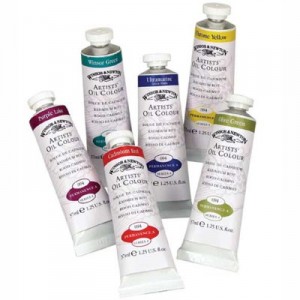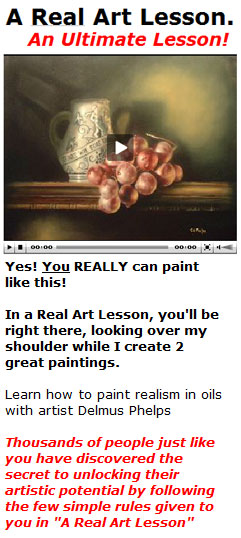Oil Painting Lesson Step 3
Posted by admin | Under Oil Painting Friday Apr 23, 2010 To start the lesson follow the steps below:
To start the lesson follow the steps below:
Read Introduction on Landscape Oil Paintings
Follow Oil Painting Lesson Step 1
Follow Oil Painting Lesson Step 2
Follow Oil Painting Lesson Step 3
Follow Oil Painting Lesson Step 4
Follow Oil Painting Lesson Step 5
Follow Oil Painting Lesson Step 6
Step 3
Dip the tip of your palette knife in black or a dark color, while allowing some of the paint to c08t the upper edges of the knife as well. Beginning from just about the center of your horizontal schemer draw 4- or S-inch verticals both above and below the median. The verticals on the top half 0 the canvas will be our trees. The lines below the horizontal will serve as the reflections of these trees in the water. If you want to add large branches do so with identical but smaller movements of the palette knife at pronounced horizontal angles, on the upper portion of the canvas.
You do not, of course, want to be drawing straight lines. Even pine trees have subtle contours for which such rigid lines would be inappropriate. How then should you draw these trees? Imagine the skinniest US” in the world. Duplicate that shape with your hand. Do it a few times without he knife just to get the feel of it. Then take your knife and draw the trees with just that motion.
A common worry among beginners is whether the reflections will accurately mirror the shapes of the trees. Again, hink of how it works in nature. The ripples of the water invariably fuzz the reflections. Or the sunlight dances cross the surface, bending and reshaping the trees in every possible configuration. What you see in the water is, at best, I ambiguous. The fact is, you thus have enormous freedom when painting the reflections. Just follow your common sense, but don’t worry if you .can’t render a precise mirror l image. If you have drawn large branches and now want their reflections as well, merely squiggle them in on the flower part of the canvas. Once again, rigorous precision is simply not necessary.
The next question is, how many trees should you draw? Basically, it doesn’t matter. We have already made the point that the landscape is an exciting genre simply because there are so many different routes you can follow. If your canvas is 18 inches across by 14 inches deep, a typical route would be three or four trees spaced at logical intervals. On the other hand, there are many effective paintings in which just one lone tree leans eerily off to the left or right.
There is, of course, the aesthetic issue of balance. This is almost complicated subject and we certainly don’t have the space here to explore it thoroughly. Suffice it to say that paintings should be balanced like anything else; an additional weight on the top or left should be compensated for by an analogous mass on the bottom or right. Sometime however, intentional imbalance can be very effective. A single tree all the way on the left may gain in power simply because it introduces a striking asymmetry into the proceedings.
The problem of balance can be approached in many ways, and it will be helpful to mention just one for your future experimentation. Through many centuries of trial and error, artists arrived at the conclusion that some colors Neigh more than others. The so-called “warm” colors, like red and orange, weigh more than the “cool” ones, like blue. (To remember which are which, just associate blue with an Eskimo’s lips and red with the color of a Sahara sun.) Now if you are only drawing one tree and sticking it off to the left, you can still make the composition symmetrical by adding a streak of red or dark yellow on the right. The weight of those extra-warm colors will serve to balance the tree at the opposite end.
At the ground level, streaks of red will emphasize the solidity of the land. Paint them in now. The more you learn about painting, the more you realize how complex are the problems of light. For example, after you have drawn the reflections of the trees, try drawing their shadows. A novice might guess that the problem here would be to accurately capture the actual shape of a shadow. Not at all! What you really need for a shadow is a small dark line at the base of a tree drawn in with a quick jab of the knife. Anything more would be intrusive, whereas that brief squiggle jutting out I from the trunk will tell the viewer all he needs to know.
The real problem is where to put the shadow. Its position must be determined by the direction of the light. Here light becomes a taskmaster. When we drew the reflections of the trees, we saw that the light on the water would render them phantasmagoric (optically indistinct) and thus give us more freedom in depicting them. In contrast, light dictates that a shadow must be here and not there, this way and not that way. In painting shadows we must obey its dictates. So what I suggest is that until you master the subtleties of light, it’s lest to assume that the sun is pouring in from the upper left comer of the canvas. That way, you will always be safe drawing the shadows in a left-to-right direction. I would recommend about a 25° angle from the base of the trunk downwards.
Next, touch up the tree trunks with a lighter color to once again create depth. Here, use the knife to trace just the edges of the trunks. Even a pure white will be effective for this. What emerges won’t be simple depth but an actual vibration, as if the dark comers of the bark are shimmering in the sun. Our trees will seem to jump alive as a result. Next time you go to a museum notice how many of the great landscapes on view feature lakes and haystacks and trees that seem wispy, almost evanescent. The masters knew best of all what light does to solid substances, how it makes even the heaviest forms shimmer in the breeze. There is absolutely no reason why you can’t achieve the same effect by imply applying subtle tinges of white to the edges of your trees.
As part of our third step, we can draw the roots of the trees directly below the trunks. Oddly enough, it really doesn’t matter what color you choose. In fact the darker the tree the more I’d recommend a lighter tone. Again our real purpose is to create form through contrast and depth. Never mind that most roots are actually heavy and brown. Unless you’re planning to draw the enormous vinelike roots of a fig tree, it’s really more important to avail yourself of yet another opportunity to intensify the overall effect of your canvas. Indeed, there are times when a white tone, much like the one with which we touched up the edges of the trees, will be most effective.
Being true to nature with your colors is not therefore all that important. Obviously you don’t want a pink sky and orange lagoon. But the real soul of art is form, and the same light that creates form also plays recklessly with color. Those roots, which we would normally expect to be brown, are subject to a thousand unpredictabilities of the sun. Any color might be reflecting upwards from the base of the trunk.
Everything you do should be with a thought towards form: light and color, composition and balance. Sculptors create form automatically by the simple nature of their materials. But in painting, there is no wood or marble looming towards the viewer, nothing extending from the surface, as in sculpture. You must rely totally on your own devices. When, for example, you draw the roots with your palette knife, be as squiggly as possible. The same narrow US” with which you drew the trees might work.
Remember that form has been the helpless plaything of nature for eons. It has been gnarled, torn and broken by the ravages of time, just like a checking account that is overdrawn. So pretend that your wrist is a ballet dancer. Let it shimmy gracefully at every step and thereby capture nature’s form in all its uneven grandeur.
Before moving on to the next step, we want to add some character to the ground and the trees. Put a glob of paint at the tip of your palette knife. A dark color might well be advisable here. Turn and twist the knife in the paint until it looks like a string bean hanging down. Then apply it to the tops of the trees. Whether you have painted branches or just a single trunk, these additions will give much greater body to the trees. You’ll really notice this in the next step, when we use toilet paper to create our leaves.
